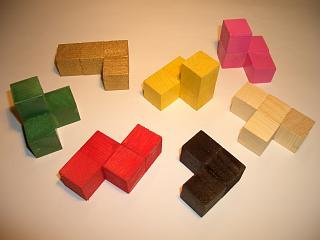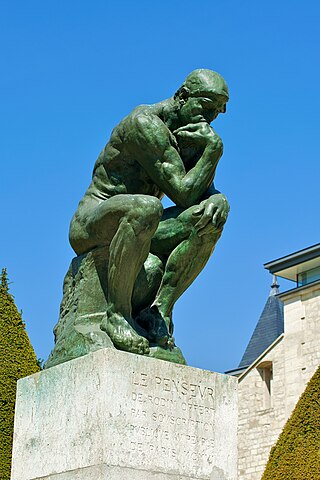Related Research Articles
The eight queens puzzle is the problem of placing eight chess queens on an 8×8 chessboard so that no two queens threaten each other; thus, a solution requires that no two queens share the same row, column, or diagonal. There are 92 solutions. The problem was first posed in the mid-19th century. In the modern era, it is often used as an example problem for various computer programming techniques.

The Rubik's Cube is a 3D combination puzzle invented in 1974 by Hungarian sculptor and professor of architecture Ernő Rubik. Originally called the Magic Cube, the puzzle was licensed by Rubik to be sold by Pentangle Puzzles in the UK in 1978, and then by Ideal Toy Corp in 1980 via businessman Tibor Laczi and Seven Towns founder Tom Kremer. The cube was released internationally in 1980 and became one of the most recognized icons in popular culture. It won the 1980 German Game of the Year special award for Best Puzzle. As of January 2024, around 500 million cubes had been sold worldwide, making it the world's bestselling puzzle game and bestselling toy. The Rubik's Cube was inducted into the US National Toy Hall of Fame in 2014.
Recreational mathematics is mathematics carried out for recreation (entertainment) rather than as a strictly research-and-application-based professional activity or as a part of a student's formal education. Although it is not necessarily limited to being an endeavor for amateurs, many topics in this field require no knowledge of advanced mathematics. Recreational mathematics involves mathematical puzzles and games, often appealing to children and untrained adults and inspiring their further study of the subject.

The Soma cube is a solid dissection puzzle invented by Danish polymath Piet Hein in 1933 during a lecture on quantum mechanics conducted by Werner Heisenberg.
A chess puzzle is a puzzle in which knowledge of the pieces and rules of chess is used to solve logically a chess-related problem. The history of chess puzzles reaches back to the Middle Ages and has evolved since then.
A puzzle is a game, problem, or toy that tests a person's ingenuity or knowledge. In a puzzle, the solver is expected to put pieces together in a logical way, in order to find the solution of the puzzle. There are different genres of puzzles, such as crossword puzzles, word-search puzzles, number puzzles, relational puzzles, and logic puzzles. The academic study of puzzles is called enigmatology.

Ernő Rubik is a Hungarian inventor, widely known for creating the Rubik's Cube (1974), Rubik's Magic, and Rubik's Snake.

Rubik's Magic, like the Rubik's Cube, is a mechanical puzzle invented by Ernő Rubik and first manufactured by Matchbox in the mid-1980s.

Kakuro or Kakkuro or Kakoro is a kind of logic puzzle that is often referred to as a mathematical transliteration of the crossword. Kakuro puzzles are regular features in many math-and-logic puzzle publications across the world. In 1966, Canadian Jacob E. Funk, an employee of Dell Magazines, came up with the original English name Cross Sums and other names such as Cross Addition have also been used, but the Japanese name Kakuro, abbreviation of Japanese kasan kurosu, seems to have gained general acceptance and the puzzles appear to be titled this way now in most publications. The popularity of Kakuro in Japan is immense, second only to Sudoku among Nikoli's famed logic-puzzle offerings.

David Breyer Singmaster was an American-British mathematician who was emeritus professor of mathematics at London South Bank University, England. He had a huge personal collection of mechanical puzzles and books of brain teasers. He was most famous for being an early adopter and enthusiastic promoter of the Rubik's Cube. His Notes on Rubik's "Magic Cube" which he began compiling in 1979 provided the first mathematical analysis of the Cube as well as providing one of the first published solutions. The book contained his cube notation which allowed the recording of Rubik's Cube moves, and which quickly became the standard.

Sudoku is a logic-based, combinatorial number-placement puzzle. In classic Sudoku, the objective is to fill a 9 × 9 grid with digits so that each column, each row, and each of the nine 3 × 3 subgrids that compose the grid contains all of the digits from 1 to 9. The puzzle setter provides a partially completed grid, which for a well-posed puzzle has a single solution.
Trevor Truran is a United Kingdom former mathematics teacher, best known as the creator of many games and puzzles. Truran began making up games as mathematical teaching aids. At one time his entire mathematics course for 9-13 year olds was based on games, puzzles and story situations.
God's algorithm is a notion originating in discussions of ways to solve the Rubik's Cube puzzle, but which can also be applied to other combinatorial puzzles and mathematical games. It refers to any algorithm which produces a solution having the fewest possible moves. The allusion to the deity is based on the notion that an omniscient being would know an optimal step from any given configuration.

The mutilated chessboard problem is a tiling puzzle posed by Max Black in 1946 that asks:
Suppose a standard 8×8 chessboard has two diagonally opposite corners removed, leaving 62 squares. Is it possible to place 31 dominoes of size 2×1 so as to cover all of these squares?

A combination puzzle, also known as a sequential move puzzle, is a puzzle which consists of a set of pieces which can be manipulated into different combinations by a group of operations. Many such puzzles are mechanical puzzles of polyhedral shape, consisting of multiple layers of pieces along each axis which can rotate independently of each other. Collectively known as twisty puzzles, the archetype of this kind of puzzle is the Rubik's Cube. Each rotating side is usually marked with different colours, intended to be scrambled, then solved by a sequence of moves that sort the facets by colour. Generally, combination puzzles also include mathematically defined examples that have not been, or are impossible to, physically construct.

KenKen and KenDoku are trademarked names for a style of arithmetic and logic puzzle invented in 2004 by Japanese math teacher Tetsuya Miyamoto, who intended the puzzles to be an instruction-free method of training the brain. The name derives from the Japanese word for cleverness. The names Calcudoku and Mathdoku are sometimes used by those who do not have the rights to use the KenKen or KenDoku trademarks.

Embodied design grows from the idea of embodied cognition: that the actions of the body can play a role in the development of thought and ideas. Embodied design brings mathematics to life; studying the effects of the body on the mind, researchers learn how to design objects and activities for learning. Embodiment is an aspect of pattern recognition in all fields of human endeavor.

Taking Sudoku Seriously: The Math Behind the World's Most Popular Pencil Puzzle is a book on the mathematics of Sudoku. It was written by Jason Rosenhouse and Laura Taalman, and published in 2011 by the Oxford University Press. The Basic Library List Committee of the Mathematical Association of America has suggested its inclusion in undergraduate mathematics libraries. It was the 2012 winner of the PROSE Awards in the popular science and popular mathematics category.
References
- ↑ Kulkarni, D. Enjoying Math: Learning Problem Solving With KenKen Puzzles Archived 2013-08-01 at the Wayback Machine , A textbook for teaching with KenKen Puzzles.